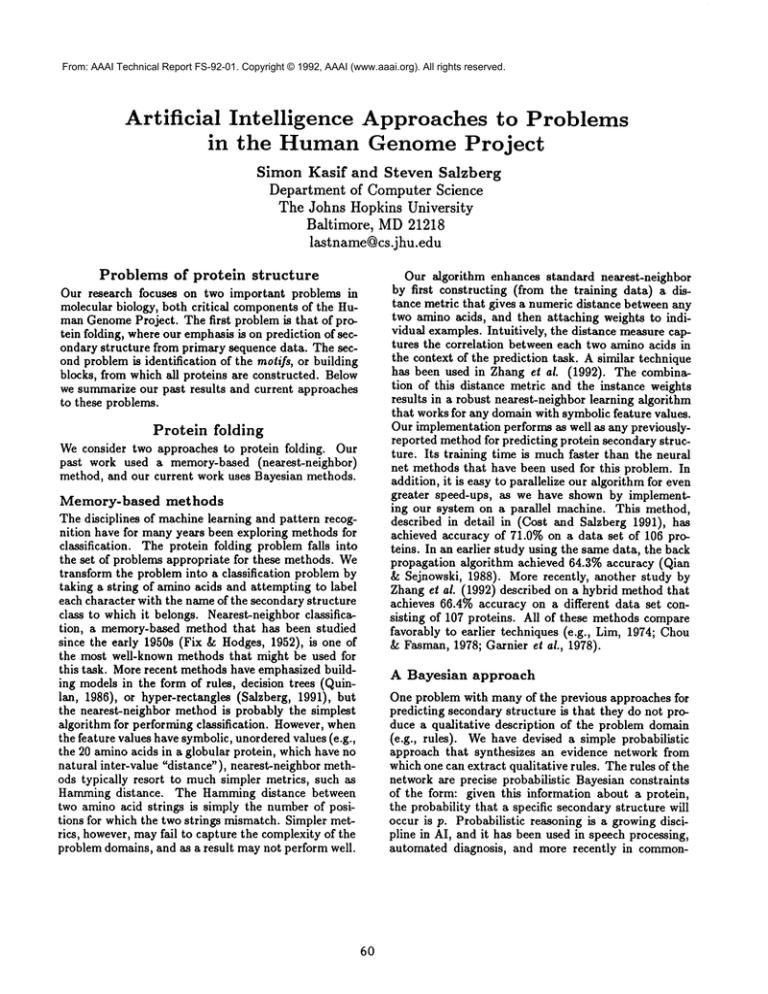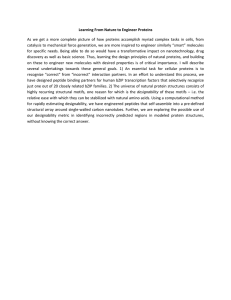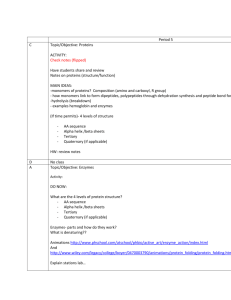
From: AAAI Technical Report FS-92-01. Copyright © 1992, AAAI (www.aaai.org). All rights reserved.
Artificial
Intelligence
Approaches to Problems
in the Human Genome Project
Simon Kasif and Steven Salzberg
Department of Computer Science
The Johns Hopkins University
Baltimore,
MD21218
lastname@cs.jhu.edu
Problems of protein
structure
Our research focuses on two important problems in
molecular biology, both critical componentsof the HumanGenomeProject. The first problemis that of protein folding, whereour emphasisis on prediction of secondary structure from primary sequencedata. The second problemis identification of the motifs, or building
blocks, from whichall proteins are constructed. Below
we summarizeour past results and current approaches
to these problems.
Protein folding
Weconsider two approaches to protein folding. Our
past work used a memory-based(nearest-neighbor)
method, and our current work uses Bayesian methods.
Memory-based
methods
The disciplines of machinelearning and pattern recognition have for manyyears been exploring methodsfor
classification. The protein folding problemfalls into
the set of problemsappropriate for these methods. We
transform the probleminto a classification problemby
taking a string of aminoacids and attempting to label
each character with the nameof the secondarystructure
class to whichit belongs. Nearest-neighborclassification, a memory-basedmethod that has been studied
since the early 1950s (Fix & Hodges,1952), is one
the most well-knownmethods that might be used for
this task. Morerecent methodshave emphasizedbuilding modelsin the form of rules, decision trees (Quinlan, 1986), or hyper-rectangles (Salzberg, 1991),
the nearest-neighbor methodis probably the simplest
algorithm for performingclassification. However,when
the feature values havesymbolic,unorderedvalues (e.g.,
the 20 aminoacids in a globular protein, whichhaveno
natural inter-value "distance"), nearest-neighbormethods typically resort to muchsimpler metrics, such as
Hammingdistance. The Hammingdistance between
two aminoacid strings is simply the numberof positions for whichthe two strings mismatch.Simpler metrics, however,mayfail to capture the complexityof the
problemdomains,and as a result maynot performwell.
6O
Our algorithm enhances standard nearest-neighbor
by first constructing (from the training data) a distance metric that gives a numericdistance betweenany
two aminoacids, and then attaching weights to individual examples.Intuitively, the distance measurecaptures the correlation betweeneach two amino acids in
the context of the prediction task. A similar technique
has been used in Zhanget ai. (1992). The combination of this distance metric and the instance weights
results in a robust nearest-neighborlearning algorithm
that worksfor any domainwith symbolicfeature values.
Our implementationperformsas well as any previouslyreported methodfor predicting protein secondarystructure. Its training time is muchfaster than the neural
net methodsthat have been used for this problem. In
addition, it is easy to parallelize our algorithmfor even
greater speed-ups, as we have shown by implementing our system on a parallel machine. This method,
described in detail in (Cost and Salzberg 1991), has
achieved
accuracy
of 71.0%on a datasetof I00proteins.
Inanearlier
study
using
thesamedata,
theback
propagation
algorithm
achieved
64.3%accuracy
(Qian
& Sejnowski,
1988).
Morerecently,
another
studyby
Zhang
et al.(1992)
described
ona hybrid
method
that
achieves 66.4%accuracy on a different data set consisting of 107 proteins. All of these methodscompare
favorably to earlier techniques (e.g., Lim, 1974; Chou
& Fasman,1978; Gamieret al., 1978).
A Bayesian
approach
Oneproblem with manyof the previous approaches for
predicting secondarystructure is that they do not produce a qualitative description of the problem domain
(e.g., rules). Wehave devised a simple probabilistic
approach that synthesizes an evidence network from
whichone can extract qualitative rules. Therules of the
networkare precise probabilistic Bayesianconstraints
of the form: given this information about a protein,
the probability that a specific secondarystructure will
occur is p. Probabilistic reasoning is a growingdiscipline in AI, and it has been used in speech processing,
automated diagnosis, and more recently in common-
From: AAAI Technical Report FS-92-01. Copyright © 1992, AAAI (www.aaai.org). All rights reserved.
sense reasoning. Weare interested in using this framework to devise probabilistic belief networks (e.g., causal
trees such as those developed by Pearl (1988)) for
wide range of tasks involving scientific analysis of data.
Previous work in AI on scientific discovery has been
based on a different paradigm. Our current work is
aimed at using the belief network frameworkto discover
new rules about protein folding. The well-done study
by Zhang et al. (1992) describes another probabilistic
method for the same problem which is similar in spirit
to our approach.
Searching for motifs
It has been conjectured by several prominent molecular
biologists (John Gilbert, Hamilton Smith and others)
that all proteins were formed from a commonset of
motifs, or building blocks. This conjecture is based on
the hypothesis that nature typically does not tend to
invent new mechanisms, but rather reuses and modifies
old ones. These motifs (sequences of conserved aminoacids) are, presumably, short sequences of amino acids
that can be found in proteins from widely varying life
forms. However, until recently it has been impossible
to gather evidence supporting this hypothesis, because
of the lack of sequence data. With the growth of the
protein sequence data base in recent years, it now may
be possible to find motifs and perhaps to refine and verify this conjecture. Finding these building blocks could
revolutionize molecular biology and protein structure
research. Work has begun recently at a small number
of places, including Johns Hopkins, to develop methods
for finding motifs (Smith et al. 1990).
Most of the work on searching protein sequences
has focused on pairwise sequence alignment, with some
more recent algorithms dedicated to multiple sequence
alignment. Optimal multiple sequence alignment problems are typically NP-hard, and solution methods typically use greedy heuristic methods. However,even these
heuristic algorithms are too expensive to apply to large
sets of proteins, since their complexityis usually O(nm),
for m proteins of length n (Lipman et al. 1989. The
motif problem does not require alignment of entire proteins, since motifs are only small subsequences, and thus
less expensive algorithms may be devised.
Our current approach uses clustering methods to attempt to find significant clusters of short sequences, in
which the average intra-cluster distance is minimized,
while the inter-cluster distance is maximized. To test
our approach, we have gathered a large database containing over 2000 proteins, with the help of collaborators from the Human GenomeDatabase (Prof. Ken
Fasman) and in the Department of Molecular Biology
(Prof. Hamilton Smith). Our current algorithms have
quadratic complexity, and the size of this database
presents a computationally expensive problem: the
database has over 600,000 strings that are considered
to be candidate motifs, where each such string is of
61
length k. (We vary k in our experiments, but the number of strings is basically the same for 10 < k < 50.)
Thus a quadratic algorithm requires roughly 3.6x 1011
iterations. In order to avoid this expensive calculation,
we have chosen heuristic methods such as the following:
choose a small numberof proteins (e.g., 100), find good
candidate motifs, and then search the entire database to
determine whether or not those motifs occur frequently
across all proteins. Wehave also devised a simple data
structure which is a variant of discrimination net (trie).
The data structure compresses the data using a labelled
tree. Each path in the tree is a prefix of some string
in the database. Thus, all strings that share a common
prefix are sons of the same node. This saves us from
comparing the same prefixes over and over. The data
structure will allow us to achieve substantial constant
speed-up for clustering.
Critical
issues
for discussion
presentations
and
Scientific analysis of data is a very important application area for AI research. Traditional methods of data
analysis, e.g., regression analysis, typically do not function adaptively and require substantial user guidance.
They do not generate hierarchical concept descriptions
(e.g, decision trees or rules). Theydo not generate qualitative domain descriptions. They do not generate experiments to validate partially constructed models.
Webelieve the ultimate data analysis system using
AI techniques will integrate a variety.of data analysis
tools and will do all of the above. It should have a
wide range of analysis tools (including statistical methods) at its disposal. It will adaptively choose various
methods and automatically modify its behavior based
on partial findings. It will be able to generate simulations automatically and verify models constructed
based on a given data set. When the model does
not fit the data, the system will try to explain the
source of error, conduct additional experiments, and
choose a different model by modifying system parameters. Whenit needs user guidance, it will produce
a simple low-dimensional view of the model and the
multi-dimensional data, which will allow the user to
guide the system in designing the next set of experiments.
Our preliminary work on the motif problem fits this
general paradigm. Our system comes up with a set
of candidate motifs (a model) and tries to validate the
model on the full data set. Whenthe model does not fit
the data (which happens frequently), the system sampies the data again and produces a different model. We
are in the process of constructing other analysis tools
(in addition to clustering). It will be most interesting
to have the system integrate results from different data
analysis programs and modify its behavior based on the
partial results.
From: AAAI Technical Report FS-92-01. Copyright © 1992, AAAI (www.aaai.org). All rights reserved.
In the conference, we would like to discuss the general paradigm of data analysis based on AI techniques.
Along these lines, we can present our work on secondary structure prediction, described above, and our
new Bayesian approach. Wecan also present our workin-progress on the motif problem and the preliminary
results we have.
Recent related
publications
authors
by the
Cost, S. and S. Salzberg (1992). A Weighted Nearest
Neighbor Algorithm for Learning with Symbolic Features. MachineLearning, in press.
Cost, S. and S. Salzberg (1990). Exemplar-based
Learning to Predict Protein Folding. Proceedings of the
Iggo Symposium on Computer Applications in Medical Care (pp. 114--118), Washington, D.C., November
1990.
Heath, D., S. Kasif, and S. Salzberg (1992). Learning
oblique decision trees. Technical Report JHU-92/05,
Department of Computer Science, Johns Hopkins University, April 1992.
Kasif, S., A. Delcher, S. Salzberg, and B. Hsu (1992).
Secondary Prediction with Probabilistic Belief Methods, JHUTechnical Report (in preparation).
Salzberg, S. (1992). Predicting Protein Secondary
Structure with a Nearest-Neighbor Algorithm. Journal
of Molecular Biology, to appear, 1992.
Salzberg, S. (1991) Distance Metrics for InstanceBased Learning. Methodologies for Intelligent
Systems: 6th International Symposium, ISMIS ’91, Z. Ras
and M. Zemankova (eds.),
pp. 399-408. New York:
Springer-Verlag, 1991.
Salzberg, S. (1991). A Nearest Hyperrectangle
Learning Method. Machine Learning, 6, 251-276.
Salzberg, S., A. Delcher, D. Heath, and S. Kasif
(1991). Learning with a Helpful Teacher. Proceedings
of the Twelfth International Joint Conference on Artificial Intelligence (pp. 705-711). Sydney, Australia,
August 1991.
Other references
Chou, P. & Fasman, G. (1978). Prediction of the
secondary structure of proteins from their amino acid
sequence. Advanced Enzymology 47, 45-148.
Fix, E.F. & Hodges, J.L. (1952). Discriminatory
analysis: Nonparametric discrimination: Small sample
performance. Project 21-49-004, Report No. 11, USAF
School of Aviation Medicine, Randolph Field, Texas,
1952, 280-322.
Gamier, J., D. Osguthorpe, & B. Robson (1978).
Analysis of the accuracy and implication of simple
62
methods for predicting the secondary structure of globular proteins. J. Mol. Biol. 120, 97-120.
Lira, V. (1974). Algorithms for prediction of a-helical
and beta-structural regions in globular proteins. J. Moi.
Biol. 88, 873-894.
Lipman, D., S. Altschul, and J. Kececioglu (1989).
A tool for multiple sequence alignment. Proceedings of
the National Academyof Sciences, 86, 4412-4415.
Pearl, J. (1988). Probabilistic Reasoning in Intelligent Systems. Los Altos, CA: Morgan Kaufmann.
Qian, N. &: T. Sejnowski (1988). Predicting the secondary structure of globular proteins using neural network models. J. Mol. Biol. 202, 865-884.
Smith, H., T. Annan, and S. Chandrasegaran (1990).
Finding sequence motifs in groups of functionally related proteins. Proceedings of the National Academyof
Sciences, 87, 826-830.
Zhang, X., J. Mesirov, & D. Waltz (1992). A hybrid
system for protein secondary structure prediction. J.
Moi. BioL, in press.






